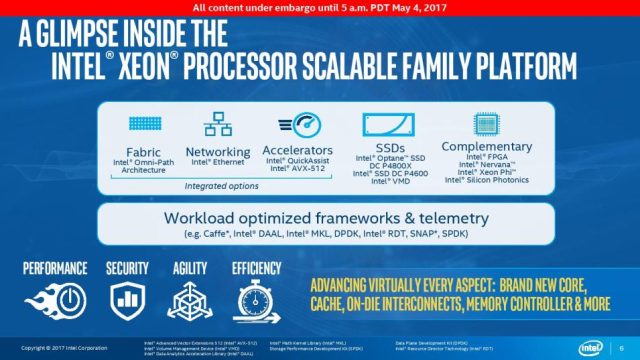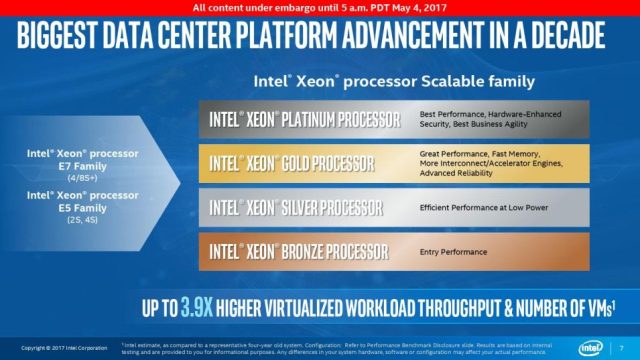The next generation of Xeons, due to arrive this summer, will make up what Intel calls the "Xeon Scalable Processor Family." This explains the change in core naming that is accompanying the new branding; the SP suffix is replacing the E, EP, and EX suffixes used in previous-generation Xeons.

The change is motivated by the increased diversity in what Intel actually sells. Processors aren't just processors any more; integrated Ethernet networking is already commonplace, and, with the Xeon-SP platform, Intel plans to integrate its QuickAssist accelerators (currently available as PCIe cards that accelerate cryptography and compression workloads), the AVX512 vector instruction extensions, and its Omni-Path interconnect. Intel also sells more than just processors and is positioning its Optane memory, FPGAs, Xeon Phi many-core accelerators, and silicon photonics products as broader parts of the platform.
Under the old branding scheme, multiple elements of processor design were conflated. Intel built three iterations of each core: low core count (LCC), medium/high core count (MCC/HCC), and extreme core count (XCC). Their primary differentiator was their core count and cache size, but these variations were also tied to the E3/E5/E7 family. Under this system, certain needs were left poorly addressed. For example, an 8-socket E7-branded XCC processor might be a good fit for a particular workload because of its large cache, but a customer might only want to use it in a 1- or 2-socket configuration, and hence wouldn't consider it.

The new scheme should be more flexible. The metal will imply the range of features integrated, with Bronze representing basic processors, Silver low power, Gold adding different options for advanced interconnects and integrated accelerators, and Platinum offering the widest range of capabilities. It seems as if Intel will be able to offer, for example, an LCC design with Platinum features for workloads with a strong dependence on the accelerators and add-in cards (or add-in processors) like Xeon Phi, or an XCC part with Bronze features for workloads that can use lots of cores and cache but don't need any of the more exotic capabilities that Intel offers.
However, the exact configurations are at present a complete unknown. Although the Gold and Platinum leak last month revealed many, many different model numbers, there's no indication yet of what those model numbers actually mean. As such, we still don't know exactly what combinations of core count, socket count, and features will be offered, and so we don't know how much of a change the new platform truly represents. That information won't arrive until nearer to the launch of the actual processors.
Listing image by Intel
reader comments
58